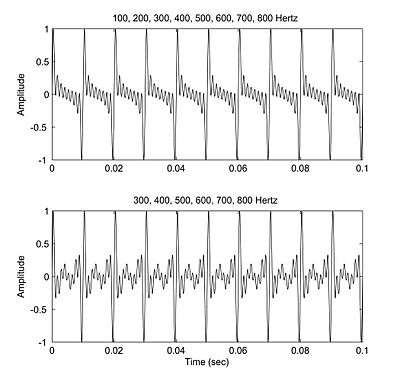
The pitch being perceived with the first harmonic being absent in the waveform is called the missing fundamental phenomenon.[1]
It is established in psychoacoustics that the auditory system, with its natural tendency to distinguish a tone from another, will persistently assign a pitch to a complex tone given that a sufficient set of harmonics are present in the spectrum.[2]
For example, when a note (that is not a pure tone) has a pitch of 100 Hz, it will consist of frequency components that are integer multiples of that value (e.g. 100, 200, 300, 400, 500.... Hz). However, smaller loudspeakers may not produce low frequencies, so in our example, the 100 Hz component may be missing. Nevertheless, a pitch corresponding to the fundamental may still be heard.
- ^ Howard, David M.; Angus, J. A. S. (2017). Acoustics and Psychoacoustics Fifth Edition (5th ed.). New York: Routledge. p. 123. ISBN 9781315716879.
- ^ Hartmann, William (December 1996). "Pitch, Periodicity, & Auditory Organization" (PDF). Acoustical Society of America. 100 (6): 3491–3902. doi:10.1121/1.417248. PMID 8969472 – via Michigan State University.